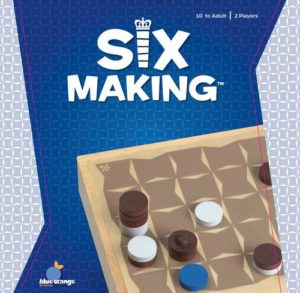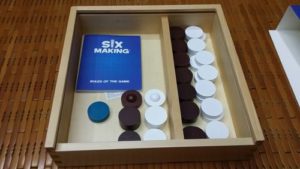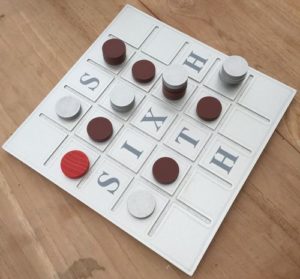 The simplest ideas are often the best.
The simplest ideas are often the best.
Yes, I recognize that statement is highly clichéd, but it happens to fit perfectly in the case of the game Six Making.
I will admit the name of this 2013 release from designer József Dorsonczky is not the most elegant, but everything else about the game is great.
To start with I have the Blue Orange Games version of Six Making, which means it comes in a wooden box, the lid reversing to become the 5X5 board. The pieces are wood as well. So the aesthetics are very nice.
The game has very simple rules and plays quite quickly, yet within that, there is a lot of opportunity for strategic gameplay.
In this two-player game, each player starts with 15 checkers in their colour, which starts off the game board.
On a turn, a player may add one playing piece of their colour on any unoccupied space, or they may perform a capture on the board, using any piece in play.
 That is one of the really interesting aspects of gameplay with Six Making, once in play either player can move any of the pieces on the board, but only to capture.
That is one of the really interesting aspects of gameplay with Six Making, once in play either player can move any of the pieces on the board, but only to capture.
Captured pieces are not removed from the board. They simply become part of the stack of pieces which did the capturing.
Again herein lies a cool aspect of Six Making. Each time a tower is elevated by one rank, it takes on a new movement characteristic (based on the movement rules of chess). So a one disk tower moves like a slightly modified pawn, (one space orthogonally), a two-piece stack moves like a rook, a three like a knight, a four like a bishop, a five like a queen, and a six (or more) elevates to a king. When a tower is elevated to a king, whosever’s color is on top is crowned the winner of the game. The colour of your pieces finally comes into play in this fashion.
 Yet another interesting aspect of Six Making is that when you perform a capture, you may move one or more disks from a single tower to on top of another tower. The piece moves as described above but you may leave part of the stack behind if desired. You may choose to move all the disks in a tower or just a portion of them. However many disks you choose to move, they take on the movement characteristics of the entire tower before being split. That is to say that a tower moves the same regardless of how many of its disks you choose to move.
Yet another interesting aspect of Six Making is that when you perform a capture, you may move one or more disks from a single tower to on top of another tower. The piece moves as described above but you may leave part of the stack behind if desired. You may choose to move all the disks in a tower or just a portion of them. However many disks you choose to move, they take on the movement characteristics of the entire tower before being split. That is to say that a tower moves the same regardless of how many of its disks you choose to move.
The game also comes with some bonus pieces to use to add some additional twists to the game with.
There is a ‘giant’ piece for each player. It is simply a double piece, so when it is added to the board it has the automatic movement of a rook.
 Then there is the strategic ‘hunchback’. While it is played like a regular piece, no player can perform a capture on top of a hunchback, whether by itself or on top of a stack.
Then there is the strategic ‘hunchback’. While it is played like a regular piece, no player can perform a capture on top of a hunchback, whether by itself or on top of a stack.
And finally, there is a single ‘milady’ piece, which can be placed by either player. Again it moves as a regular piece but when visible, on top of a stack, the active player must perform a capture on top of it if possible. If the milady is revealed later in the game its special capture requirement is again active.
The three additional pieces are definitely recommended to be used.
For extended play, it is suggested “every time a tower is elevated to a king, the tower is eliminated from the board and the disks that formed it are redistributed among the players. The player whose colour was on top gets one winning point. The first player to reach six points wins the game.” This is a fine concept as games are quick with Six Making.
Overall, Six Making is a highly addictive and challenging game.
